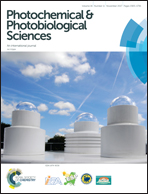Hydrazine functionalized probes for chromogenic and fluorescent ratiometric sensing of pH and F−: experimental and DFT studies†
Abstract
Two novel hydrazine based sensors, BPPIH (N1,N3-bis(perfluorophenyl)isophthalohydrazide) and BPBIH (N1′,N3′-bis(perfluorobenzylidene)isophthalohydrazide), are presented here. BPPIH is found to be a highly sensitive pH sensor in the pH range 5.0 to 10.0 in a DMSO–water solvent mixture with a pKa value of 9.22. Interesting optical responses have been observed for BPPIH in the above mentioned pH range. BPBIH on the other hand turns out to be a less effective pH sensor in the above mentioned pH range. The increase in fluorescence intensity at a lower pH for BPPIH was explained by using density functional theory. The ability of BPPIH to monitor the pH changes inside cancer cells is a useful application of the sensor as a functional material. In addition fluoride (F−) selectivity studies of these two chemosensors have been performed and show that between them, BPBIH shows greater selectivity towards F−. The interaction energy calculated from the DFT-D3 supports the experimental findings. The pH sensor (BPPIH) can be further interfaced with suitable circuitry interfaced with desired programming for ease of access and enhancement of practical applications.



 Please wait while we load your content...
Please wait while we load your content...